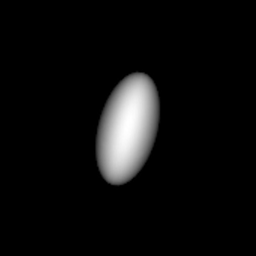Emily Lakdawalla • Sep 17, 2008
Welcome to the solar system, Haumea, Hi'iaka, and Namaka
The IAU has announced that the world formerly known as 2003 EL61 is now named Haumea. Haumea satisfies the requirements for membership in the club of dwarf planets, so it is now the fifth dwarf planet in the solar system, joining Pluto, Ceres, Eris, and Makemake.
Haumea is an oddball. Typically, the shorthand version of the definition of "dwarf planet" is bodies that are big enough to be round, but which don't have the gravitational oomph to dominate their region of the solar system. However, the "round" shorthand falls apart when you apply it to Haumea. That's because Haumea rotates once every 3.9 hours. Things that rotate fast get equatorial bulges -- just look at Saturn, which rotates once in 10 hours and is 10 percent fatter across its waist than through its poles. But Haumea is much, much smaller than Saturn, with much weaker gravity; its fast rotation gives it a "squashed rugby football shape," acording to astronomer David Rabinowitz. But it is large enough that its shape does represent a triumph of the force of gravity (counteracted at the equator by the fast spin rate) over the inherent strength of its rocky interior, so it satisfies the "dwarf planet" requirements.

Mike Brown
Haumea
Haumea, previously known as 2003 EL61, rotates once every four hours. Because of this fast rotation, it is shaped like a squashed rugby football. Its longest axis is similar to the diameter of Pluto, but its other two axes are shorter; its mass is about a third of Pluto's. This is a computer simulation of its shape.I am sure there's yet another reason for the association with the goddess of childbirth. The announcement of the discovery of 2003 EL61, now Haumea, had to be rushed forward in an untimely manner for its discoverer, Mike Brown, when another research group appeared about to be claiming primacy. At the time, Brown had a three-week-old daughter -- it was not a time when he wanted to be fielding press calls! I should note that there is some debate about who should receive discovery credit for the body formerly named 2003 EL61. The IAU has clearly decided in favor of Brown, though the Minor Planet Center gives discovery credit to Francisco José Aceituno Castro, Pablo Santos-Sanz, and Jose-Luis Ortiz (see it on this page, you have to scroll down to the entry for 2003 EL61). EDIT: yesterday the Minor Planet Center changed the discovery credit to simply "Sierra Nevada," the observatory at which Ortiz's group was based.According to amateur astronomer Reiner Stoss, Ortiz' group proposed the name Ataecina, an Iberian goddess, for 2003 EL61; the name of an Irish god, Dagda, was also proposed. In the end, the IAU accepted Brown's proposal. This dispute is likely why it has taken so long for Haumea to be named. I am really unable to comment on the relative merits of the discovery claims of Brown's and Ortiz's groups.
If I'm not mistaken, Haumea is by far the largest trans-Neptunian object that was still unnamed.
Support our core enterprises
Your support powers our mission to explore worlds, find life, and defend Earth. You make all the difference when you make a gift. Give today!
Donate

 Explore Worlds
Explore Worlds Find Life
Find Life Defend Earth
Defend Earth

